A Note About Wood
There are some things that you need to know about wood. When the masses need mass-made to keep down costs there is always a price to pay. We lose massive sections of forests in a day or two and we plantation-grow studs for stick-frame building that never mature much beyond a stud-size section that is needed. There is little waste. The wood is force-dried in a kiln because we don’t need to be concerned about distortion if it’s constrained inside a frame forming a stud wall in a mobile home. For woodworking and furniture making it is a very different story. Take that stud and rip it down the length and stresses are relieved that then reshape the stud. A straight stud so treated will then look like a boat propellor or the planking for the side of the hull for the same boat. We must then rework what might have been straight to take out the newly formed distortion. This will result in much greater expense because we lose wood every time. This distortion is the case even if the wood is dried down to 5-7% because lowered moisture content does not mean less stress and can indeed mean much higher levels of stress within the fibres of the wood. You can only imagine the tonnage of green wood stacked in this kiln. You can see how force drying stacked wood in a kiln constrains the wood to a certain level of continuously restrained conformity. Under the weight of other wood, and with the heat of the treatment itself taking place, green wood readily conforms to the pressures exerted. Taking it out of the kiln and packing, stacking and banding it tight for delivery can make a bundle look pretty good. You arrive at your Home Depot and Home Build big box store, pick up the 30 nice straight studs you need and start ripping said wood and lo, look what happens!
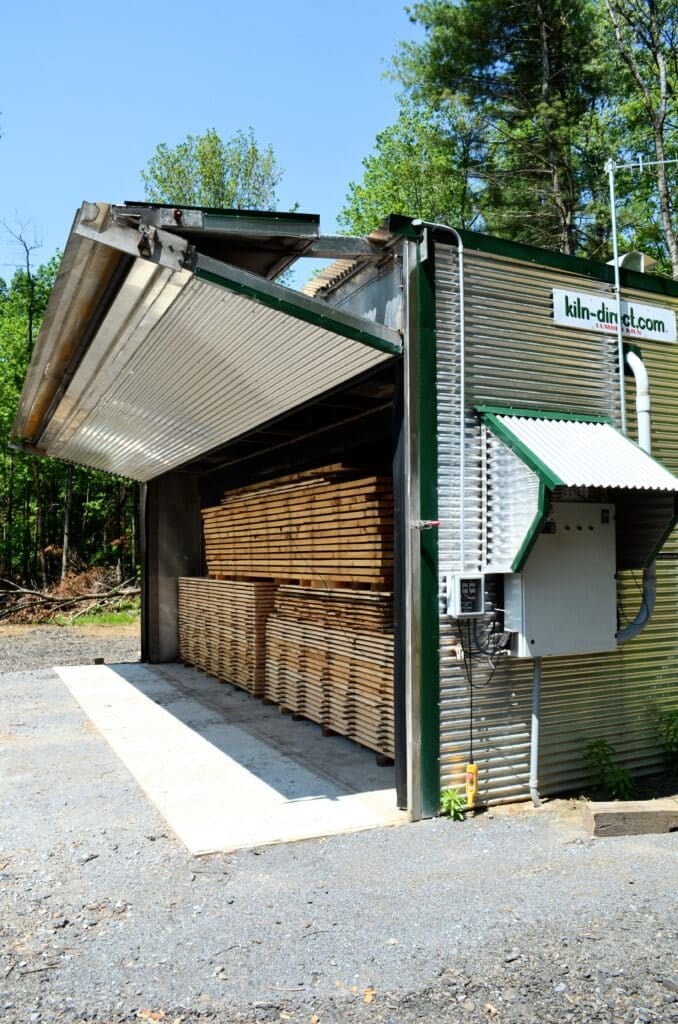
It doesn’t matter how much the wood was dried down to in the kiln process, what matters more is how it was dried and at what speed. Force drying, that is all kiln drying, speeds up the process to give us wood much sooner than if it was naturally dried by simple air stirring in between the layers and without introducing forced air and heat. Most of the wood we use these days will be kiln-dried. It is all about economics. It takes a fraction of the time it takes to passively dry our wood naturally by simply air-drying it. Using forced drying builds tension in the wood that occurs at a much lower level with air-drying. So what’s the difference? Force drying never considers what we used to call seasoning. Seasoning doesn’t actually take place with any force-drying method even though that term might still be used by mass wood processors and applied generally to all drying methods. Seasoning only happens when the log has been converted into stock sizes and the resulting wood is stickered (stacked level and with sticks of wood at regular intervals between every layer to fully support the wood and also allow air to pass freely between the layers) and air-dried. Seasoning allows the wood to move according to the gradual release of moisture. This is the reason that air-dried wood is more stable after the drying process than the kiln-dried type, but having said that, some certain wood species will always be more prone to distortion and when wood is sympathetically dried using a combination of air- and kiln-drying methods or even just kiln dried at a less forceful rate the wood will be less distressed by the process.
How to tell stress
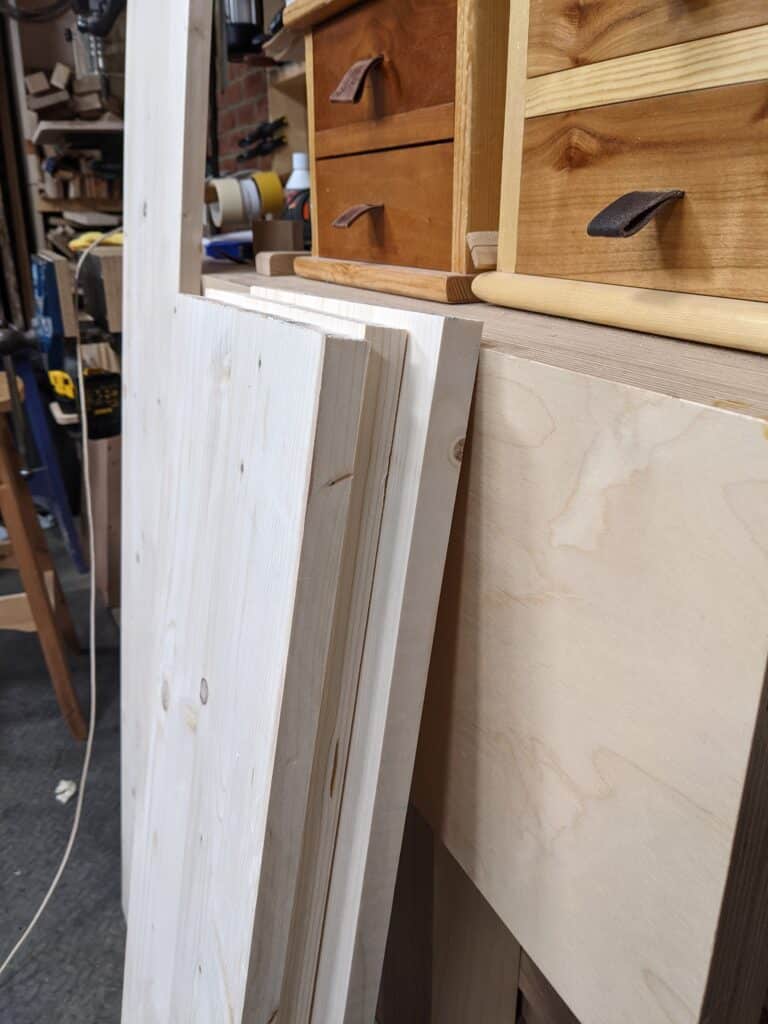
Whereas there can and often are external signs of distress in and to wood that shows after drying, all too often there will be no outward signs at all. You must rely on the supplier to work with good processing mills for his supplies. Within the wood itself, when the wood is dried too fast, there can be something called case hardening and it is this that causes the greatest distortion to newly harvested, freshly dried wood. We don’t truly see any of this until we cut into the wood. Inside, we can find separated cells and especially along the tangential rays of certain woods like oak where something called honey-combing takes place inside but is often not visible at all on the outer surfaces.
This picture below is a good example to see how the wood pulls away or curves in at the exit side of the blade. In this case, you will see that the wood to the outer left side is twisting as stress is relieved by the as-yet incomplete ripcut of the bandsaw. This relieving in a sense destresses the wood so although we see twist, cup and bow as distortions in the wood, they are the actual relaxed condition. In this case, we can see the twist taking place and also the bow forming, so by the time the piece is cut away, the remaining pieces will all have distorted to some degree.
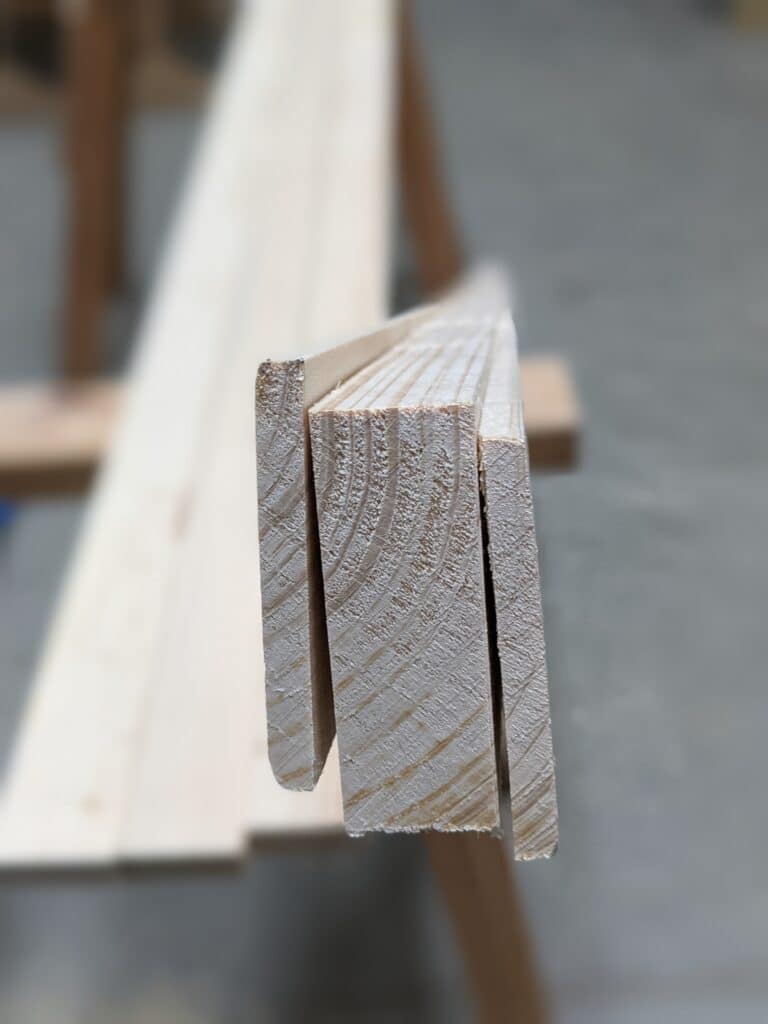
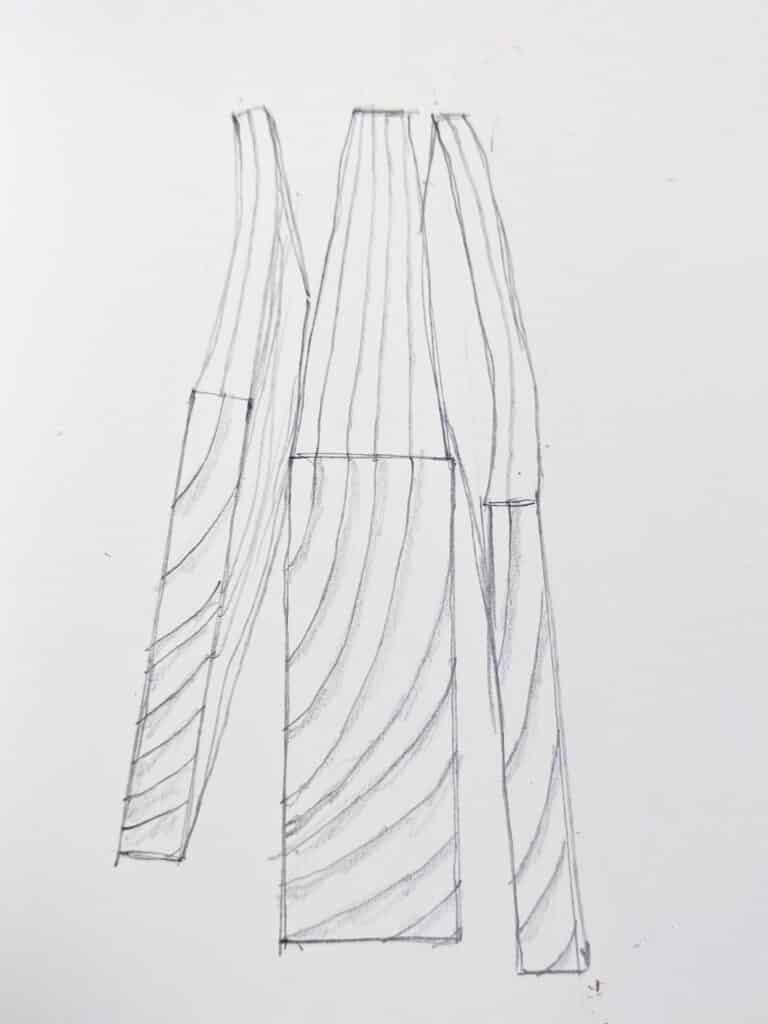
Crosscutting wood too can show the condition of stress within the wood’s fibres. In this picture, I simply took a narrow section off the end of a board with a painted end and the 8″ wide board of 1″ thick cherry opened up from the 1/16″ saw kerf at one side to a 1/4″ on the other.
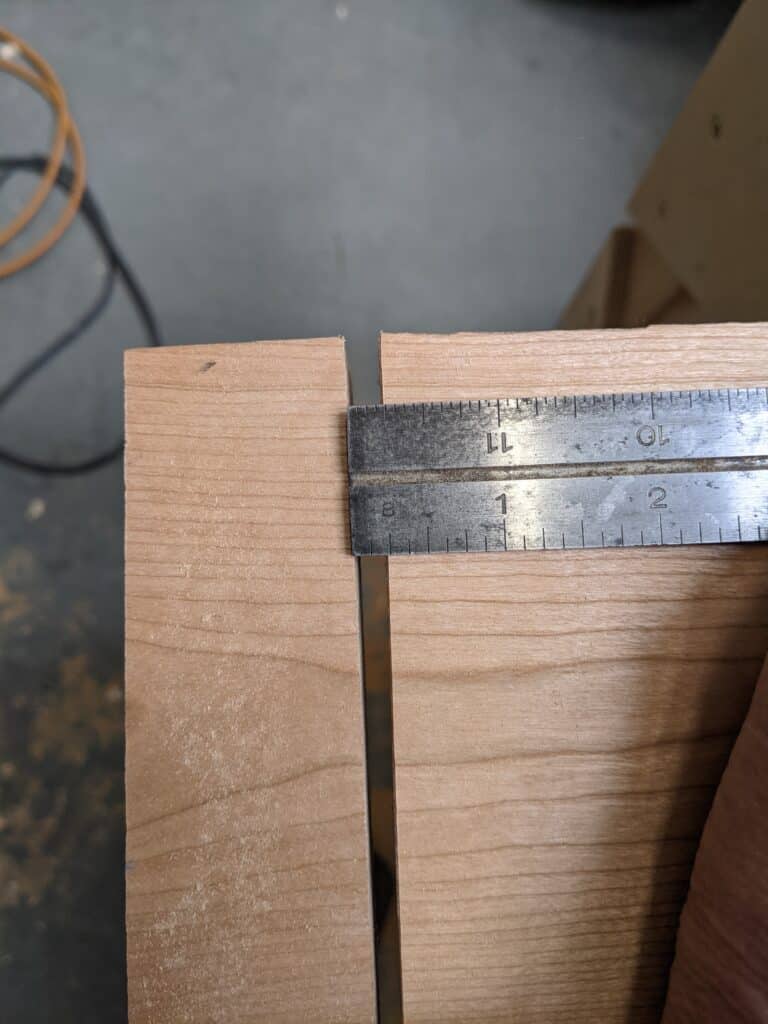


Interesting stuff! I have had some luck purchasing 2×4 lumber at the big box store. I search the stack for quarter sawn only and then bring it home and air dry the rest of the way in my basement. Right now we have a wood shortage in the eastern part of the country anyway. Lumber prices have skyrocketed from $1.94 to $6.94 for a 2×4 so they can keep the stuff. A 3/4” 4×8 sheet of warped plywood is going for over $60 from about $20.
I am fortunate however to have a saw mill that supplies local hardwood. They do an outstanding job drying their lumber. First it’s air dried then they kiln dry which takes some time. The funny thing is it’s rough sawn and the people who have more money than sense don’t know what to do with wood that’s not dimensioned. I have read articles that recommend dropping a hardwood board on a hard surface to take the stress out of the board. I don’t know if that’s true or not as I’ve never tried it.
Hi tom I find interesting your comment re wood price increase…..that is quite amazing…..can I ask are you in USA or Canada ….best John uk
john
I’m in the USA in New England.
Tom, I feel your pain. The South West [TX] isn’t doing any better. Paid $7.50 each for some 8′ SYP 2×4’s. Gets much higher and my next “just throwing something together quick” project will be using hard maple.
Hi Tom – where are you in New England? I”m in Boston and would love to see if i could go to your local saw mill too and support them
I learned these lessons first hand by building the garden bench with 2 X construction grade pine from Home Depot. There is no substitute to applying actual experience to your lessons. Thanks again.
Having read this it seems that the only way to have strait stock when you need straight stock is to buy over sized (8/4 minimum) and find the board you need with in that stock. Seems like I have a lot of learning to do. Lol. I’m i way of base?
I am not sure that you are, Jon. I do grow weary of those in the realms of knowing best and this and that cannot should not be done. In the saddle, I do all kinds of no-nos that have worked out just fine and then I do pretty much know which lines never to cross or risk. Western hardwoods do seem much more stable than we might think and keeping softwoods like pine in stock also minimises risk of warpage if you have the room. I think the important thing is to be prepared to shift your thinking and change your ideas when things go awry, that’s all. Also, I often use bowed and wood that has maybe cupped provided I can press it out with hand/arm pressure because if I can do then there is enough elasticity in the wood to tolerate it.
When I built my work bench most of the cls had been in the rafters of my garage workshop for some time. (years for some of it.) When ever I needed any I always bought extra and stored it. Although presently I am down to 1 length. I am always selective when I buy any.
The price of timber does seem to have risen recently. Perhaps less being produced due to the virus.
Another possible and potentially serious problem with kiln dried wood, especially using a power of any type is that while it is dried to a standard, shipping the wood to some remote use location after that can lead to the board pinching the saw blade during rip cuts. I found this out the hard way when a piece of yellow poplar kicked back past my right side. The wood will take up moisture on the exterior surfaces but remain much drier in the interior causing the two pieces to bow toward each other, pinching the blade. Some times this even happen with a handsaw.
I understand what is being said. Is there an alternative, and can we expect to see the powers that be change for the good…or not?
Aloha Paul,
In Hawaii, we had either to pay the price of using a commercial wood kiln or building our own. The commercial kiln cost big bucks and would waste the wood due to Case Harding. I , instead did the math and put together a Solar Powered Kiln.
Cost to run a commercial kiln 20+ years ago in Hawaii = $ 3500 each month
Cost to run a Solar Heated Kiln = $ 10 per month
6 month air dried , covered and out of the weather, than loaded into kiln for 3 months.
Since the air flow was constant flowing through the stickered wood piles of nearly milled woods[wood was left about at +1/4″ more than needed, accounting for shrinkage as well] the wood cycled between the heat of the Solar cycle and the Equalization of the night cycle, wood never came out case hardened or cracked or checked. We sliced your own veneers for tabletops and never had problems that you mentioned. Veneers laid flat and fine. No ‘potato curled pieces. The stock for Slabs and legs also held true to milling as well.
Hi all, in my experience in the uk I’ve usually bought my softwood from DIY stores / suppliers and aimed for roughsawn. Which I have continued to air dry for anything up to a year. I normally buy large dimensions and work these down to desired sizes. Typically this process has produced well balanced timber for me..
Hardwoods take me a lot longer and where possible I may even fell this myself from community forest projects.
Paul,
Great information. I thought I’ve been doing it wrong all this time by trying to get thin stock (2 one-half inch thick lengths from 4/4 stock with minimal planing to smooth). This seems to cup and/or bow worse because of the thinner 1/2″ dimension. I guess finished stock thickness is not as big of a factor as internal stresses are to cupping and bowing.
Paul, when’s the solar gentle kiln build aka the Sellers Kiln coming out? We all bought bandsaws and hand tools to your specs. My wood that i bought is warped like the Starship Enterprise!
Here in California we too are experiencing huge price increases. The industry has taken the bait and blames it on the virus. First they said they cut production as they thought the housing market would crash. It didn’t!! And now they claim they can’t find enough people to work the mills. Personally I find it Price Gouging. In Calif if during an emergency situation a company raises prices by over 10% it is termed Illegal Price Gouging. LOL they’ll prosecute the crooks.
Another problem here in Northern California we have is the lack of air-dryed or even wet/green hardwoods. All I can find are slabs from small sawers sawn to 8/4. Nice stock for live edge tables but hell for furniture construction if you don’t own a very large bandsaw.